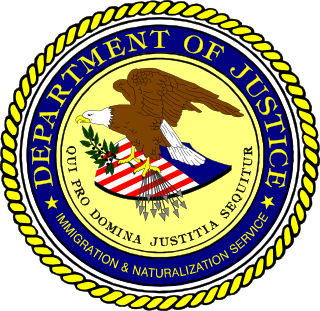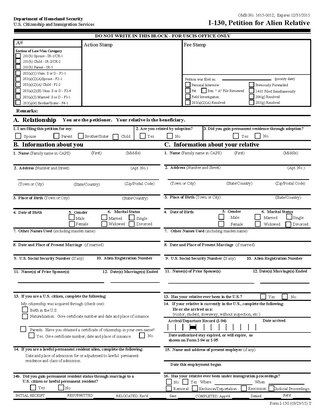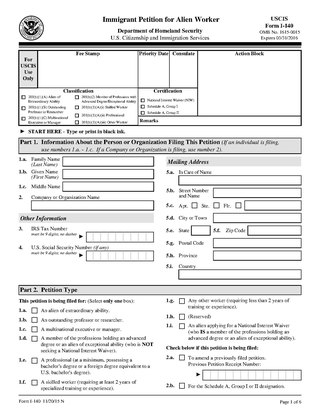
The United States Immigration and Naturalization Service (INS) was an agency of the U.S. Department of Labor from 1933 to 1940 and the U.S. Department of Justice from 1940 to 2003.

A green card, known officially as a permanent resident card, is an identity document which shows that a person has permanent residency in the United States. Green card holders are formally known as lawful permanent residents (LPRs). As of 2019, there are an estimated 13.9 million green card holders, of whom 9.1 million are eligible to become United States citizens. Approximately 18,700 of them serve in the U.S. Armed Forces.

United States Customs and Border Protection (CBP) is the largest federal law enforcement agency of the United States Department of Homeland Security. It is the country's primary border control organization, charged with regulating and facilitating international trade, collecting import duties, as well as enforcing U.S. regulations, including trade, customs and immigration. CBP is one of the largest law enforcement agencies in the United States. It has a workforce of more than 45,600 federal agents and officers. It is headquartered in Washington, D.C.
An L-1 visa is a visa document used to enter the United States for the purpose of work in L-1 status. It is a non-immigrant visa, and is valid for a relatively short amount of time, from three months to five years, based on a reciprocity schedule. With extensions, the maximum stay is seven years.

Parole, in the immigration laws of the United States, generally refers to official permission to enter and remain temporarily in the United States, under the supervision of the U.S. Department of Homeland Security (DHS), without formal admission, and while remaining an applicant for admission.

Visitors to the United States must obtain a visa from one of the U.S. diplomatic missions unless they are citizens of one of the visa-exempt or Visa Waiver Program countries.
The Security Through Regularized Immigration and a Vibrant Economy Act of 2007 or STRIVE Act of 2007 is proposed United States legislation designed to address the problem of illegal immigration, introduced into the United States House of Representatives. Its supporters claim it would toughen border security, increase enforcement of and criminal penalties for illegal immigration, and establish an employment verification system to identify illegal aliens working in the United States. It would also establish new programs for both illegal aliens and new immigrant workers to achieve legal citizenship. Critics allege that the bill would turn law enforcement agencies into social welfare agencies as it would not allow CBP to detain illegal immigrants that are eligible for Z-visas and would grant amnesty to millions of illegal aliens with very few restrictions.

A B visa is one of a category of non-immigrant visas issued by the United States government to foreign nationals seeking entry for a temporary period. The two types of B visa are the B-1 visa, issued to those seeking entry for business purposes, and the B-2 visa, issued to those seeking entry for tourism or other non-business purposes. In practice, the two visa categories are usually combined and issued as a "B-1/B-2 visa" valid for a temporary visit for either business or pleasure, or a combination of the two. Nationals of certain countries do not usually need to obtain a visa for these purposes.
The FBI Name Check is a background check procedure performed by the Federal Bureau of Investigation for federal agencies, components within the legislative, judicial, and executive branches of the federal government; foreign police and intelligence agencies; and state and local law enforcement agencies within the criminal justice system. The FBI Name Check is performed by the FBI as a part of the National Name Check Program, which dates back to Executive Order 10450 that was issued during the Eisenhower Administration. The FBI Name Check for an individual involves a search of the FBI's Central Records System Universal Index for any appearance of the name of the individual, as well as close phonetic variants and permutations of that name, in any of the records stored in the Universal Index. If any such occurrences are found, the Name Check also involves retrieval and analysis of the relevant paper and electronic files from local FBI offices and from other law-enforcement agencies.
The Office of Immigration Statistics (OIS) is an agency of the United States Department of Homeland Security under the Office of Strategy, Policy, and Plans.

The American Civics Test is an oral examination that is administered to immigrants who are applying for U.S. citizenship. The test is designed to assess the applicants' knowledge of U.S. history and government. US Citizenship and Immigration Services (USCIS) administers the test as part of the naturalization process.
Premium Processing Service is an optional premium service offered by the United States Citizenship and Immigration Services to employers filing Form I-129 or Form I-140. To avail of the service, the employer needs to file Form I-907 and include a fee that is $1,500 for the H-2B and R classifications and $2,500 for all others.
The United States Citizenship and Immigration Services (USCIS) issues a number of forms for people to submit to them relating to immigrant and non-immigrant visa statuses. These forms begin with the letter "I". None of the forms directly grants a United States visa, but approval of these forms may provide authorization for staying or extending one's stay in the United States as well as authorization for work. Some United States visas require an associated approved USCIS immigration form to be submitted as part of the application.

Form I-130, Petition for Alien Relative is a form submitted to the United States Citizenship and Immigration Services by a United States citizen or Lawful Permanent Resident petitioning for an immediate or close relative intending to immigrate to the United States. It is one of numerous USCIS immigration forms. As with all USCIS petitions, the person who submits the petition is called the petitioner and the relative on whose behalf the petition is made is called the beneficiary. The USCIS officer who evaluates the petition is called the adjudicator.

Form I-140, Immigrant Petition for Alien Worker is a form submitted to the United States Citizenship and Immigration Service (USCIS) by a prospective employer to petition an alien to work in the US on a permanent basis. This is done in the case when the worker is deemed extraordinary in some sense or when qualified workers do not exist in the US. The employer who files is called the petitioner, and the alien employee is called the beneficiary; these two can coincide in the case of a self-petitioner. The form is 6 pages long with a separate 10-page instructions document as of 2016. It is one of the USCIS immigration forms.

Systematic Alien Verification for Entitlements (SAVE) is a program managed by United States Citizenship and Immigration Services (USCIS), a branch of the U.S. Department of Homeland Security (DHS). SAVE facilitates lookups on the immigration and nationality status of individuals in the United States. It is an intergovernmental initiative designed to help federal, state, tribal, and local government agencies, or by a contractor acting on the agency's behalf, to determine eligibility for benefits, licenses or grants, government credentials, or to conduct background investigations. It is one of two programs that uses the Verification Information System (VIS). The other program is the Electronic Employment Eligibility Verification Program, also known as E-Verify, and is used by employers to verify the immigration status of employees. For additional verification, SAVE relies on the Person Centric Query System (PCQS).
The Central American Minors (CAM) Refugee and Parole Program is a U.S. refugee and parole program established in November 2014 by the Obama administration. It is a refugee protection and family reunification pathway on which several thousand families rely and for which tens of thousands more families are technically eligible. The CAM Program was designed to permit certain children and other eligible family members to escape life-threatening danger and other humanitarian crises and to reunite with parents or relatives in the United States. This program provides certain qualified parents and legal guardians to apply for their children and other eligible family members, who are nationals of and physically present in El Salvador, Guatemala, and Honduras, to come to the United States as refugees or parolees. The CAM Program has been operational from 2014 to 2017-18 when it was terminated over a series of actions; and from 2021 to the present, when it was restarted in two phases, first for some previously closed cases and then for new applications. To date, most CAM Program beneficiaries have been Salvadoran families of Temporary Protected Status (TPS) holders, making up 86 percent of applicants from the 2014–2017. Since the Biden administration restarted the CAM Program for new applications, the CAM Program has had expanded eligibility criteria, including parents and guardians with pending asylum applications or U visa petitions, which should enable many more Guatemalans and Hondurans to apply.
The Controlled Application Review and Resolution Program (CARRP) is a policy within United States Citizenship and Immigration Services (USCIS) that aims to prevent selected individuals from obtaining citizenship or immigration benefits. The policy was created in 2008 and mainly targets immigrants from Arab, Middle Eastern, Muslim and South Asian communities, with the top 5 countries being Pakistan, Iraq, India, Iran and Yemen. By law, immigration applications must be adjudicated within 180 days but the program introduces a loop of indefinite delays by citing national security or public safety concerns. Applications for naturalization, lawful permanent residency, and asylum are the most common selections for CARRP processing.
Federal policy oversees and regulates immigration to the United States and citizenship of the United States. The United States Congress has authority over immigration policy in the United States, and it delegates enforcement to the Department of Homeland Security. Historically, the United States went through a period of loose immigration policy in the early-19th century followed by a period of strict immigration policy in the late-19th and early-20th centuries. Policy areas related to the immigration process include visa policy, asylum policy, and naturalization policy. Policy areas related to illegal immigration include deferral policy and removal policy.
The Immigration Examinations Fee Account (IEFA) is an account in the Treasury of the United States into which all revenues collected from fees for immigration and naturalization are deposited, and that is used to fund the costs associated with providing the immigration and naturalization benefits. The account funds most of the operations of the United States Citizenship and Immigration Services (USCIS), the sub-agency of the U.S. Department of Homeland Security that is tasked with most of the associated work.























